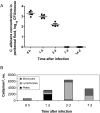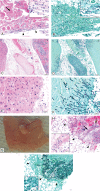Profiling of Candida albicans gene expression during intra-abdominal candidiasis identifies biologic processes involved in pathogenesis
- PMID: 24006479
- PMCID: PMC3789567
- DOI: 10.1093/infdis/jit335
Profiling of Candida albicans gene expression during intra-abdominal candidiasis identifies biologic processes involved in pathogenesis
Abstract
Background: The pathogenesis of intra-abdominal candidiasis is poorly understood.
Methods: Mice were intraperitoneally infected with Candida albicans (1 × 10(6) colony-forming units) and sterile stool. nanoString assays were used to quantitate messenger RNA for 145 C. albicans genes within the peritoneal cavity at 48 hours.
Results: Within 6 hours after infection, mice developed peritonitis, characterized by high yeast burdens, neutrophil influx, and a pH of 7.9 within peritoneal fluid. Organ invasion by hyphae and early abscess formation were evident 6 and 24 hours after infection, respectively; abscesses resolved by day 14. nanoString assays revealed adhesion and responses to alkaline pH, osmolarity, and stress as biologic processes activated in the peritoneal cavity. Disruption of the highly-expressed gene RIM101, which encodes an alkaline-regulated transcription factor, did not impact cellular morphology but reduced both C. albicans burden during early peritonitis and C. albicans persistence within abscesses. RIM101 influenced expression of 49 genes during intra-abdominal candidiasis, including previously unidentified Rim101 targets. Overexpression of the RIM101-dependent gene SAP5, which encodes a secreted protease, restored the ability of a rim101 mutant to persist within abscesses.
Conclusions: A mouse model of intra-abdominal candidiasis is valuable for studying pathogenesis and C. albicans gene expression. RIM101 contributes to persistence within intra-abdominal abscesses, at least in part through activation of SAP5.
Keywords: Candida albicans; RIM101; SAP5; in vivo gene expression; intra-abdominal candidiasis; nanoString.
Figures



Similar articles
-
Transcriptional regulators Cph1p and Efg1p mediate activation of the Candida albicans virulence gene SAP5 during infection.Infect Immun. 2002 Feb;70(2):921-7. doi: 10.1128/IAI.70.2.921-927.2002. Infect Immun. 2002. PMID: 11796627 Free PMC article.
-
Candida glabrata intra-abdominal candidiasis is characterized by persistence within the peritoneal cavity and abscesses.Infect Immun. 2014 Jul;82(7):3015-22. doi: 10.1128/IAI.00062-14. Epub 2014 May 5. Infect Immun. 2014. PMID: 24799629 Free PMC article.
-
Mucosal tissue invasion by Candida albicans is associated with E-cadherin degradation, mediated by transcription factor Rim101p and protease Sap5p.Infect Immun. 2007 May;75(5):2126-35. doi: 10.1128/IAI.00054-07. Epub 2007 Mar 5. Infect Immun. 2007. PMID: 17339363 Free PMC article.
-
Molecular genetic techniques for gene manipulation in Candida albicans.Virulence. 2014 May 15;5(4):507-20. doi: 10.4161/viru.28893. Epub 2014 Apr 23. Virulence. 2014. PMID: 24759671 Free PMC article. Review.
-
Messenger RNA transport in the opportunistic fungal pathogen Candida albicans.Curr Genet. 2017 Dec;63(6):989-995. doi: 10.1007/s00294-017-0707-6. Epub 2017 May 16. Curr Genet. 2017. PMID: 28512683 Free PMC article. Review.
Cited by
-
Intra-Abdominal Candidiasis: The Importance of Early Source Control and Antifungal Treatment.PLoS One. 2016 Apr 28;11(4):e0153247. doi: 10.1371/journal.pone.0153247. eCollection 2016. PLoS One. 2016. PMID: 27123857 Free PMC article.
-
Penetration of Ibrexafungerp (Formerly SCY-078) at the Site of Infection in an Intra-abdominal Candidiasis Mouse Model.Antimicrob Agents Chemother. 2020 Feb 21;64(3):e02268-19. doi: 10.1128/AAC.02268-19. Print 2020 Feb 21. Antimicrob Agents Chemother. 2020. PMID: 31871074 Free PMC article.
-
Cdc14 phosphatase contributes to cell wall integrity and pathogenesis in Candida albicans.Front Microbiol. 2023 Feb 16;14:1129155. doi: 10.3389/fmicb.2023.1129155. eCollection 2023. Front Microbiol. 2023. PMID: 36876065 Free PMC article.
-
Using in vivo transcriptomics and RNA enrichment to identify genes involved in virulence of Candida glabrata.Virulence. 2022 Dec;13(1):1285-1303. doi: 10.1080/21505594.2022.2095716. Virulence. 2022. PMID: 35795910 Free PMC article.
-
Candida albicans Transcriptional Profiling Within Biliary Fluid From a Patient With Cholangitis, Before and After Antifungal Treatment and Surgical Drainage.Open Forum Infect Dis. 2016 Jun 11;3(3):ofw120. doi: 10.1093/ofid/ofw120. eCollection 2016 Sep. Open Forum Infect Dis. 2016. PMID: 27703990 Free PMC article.
References
-
- Pappas PG. Invasive candidiasis. Infect Dis Clin North Am. 2006;20:485–506. - PubMed
-
- Blot SI, Vandewoude KH, De Waele JJ. Candida peritonitis. Curr Opin Crit Care. 2007;13:195–9. - PubMed
-
- Carneiro HA, Mavrakis A, Mylonakis E. Candida peritonitis: an update on the latest research and treatments. World J Surg. 2011;35:2650–9. - PubMed
-
- Party BSfACW. Management of deep Candida infection in surgical and intensive care unit patients. Intensive Care Med. 1994;20:522–8. - PubMed
-
- Blot S, De Waele JJ. Critical issues in the clinical management of complicated intra-abdominal infections. Drugs. 2005;65:1611–20. - PubMed
MeSH terms
Substances
Grants and funding
LinkOut - more resources
Full Text Sources
Other Literature Sources
Medical

